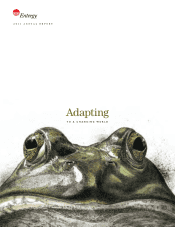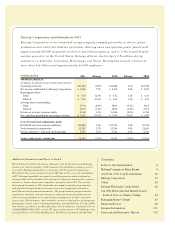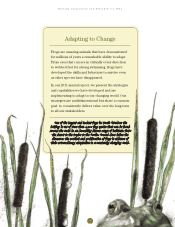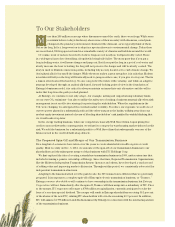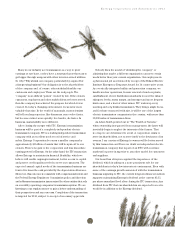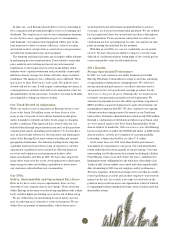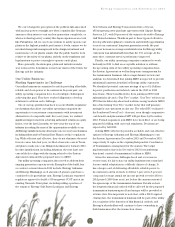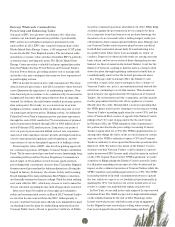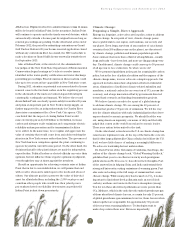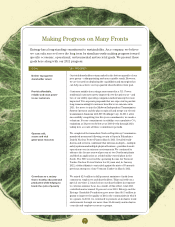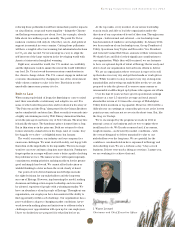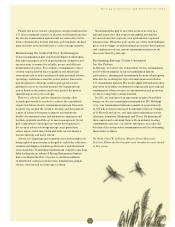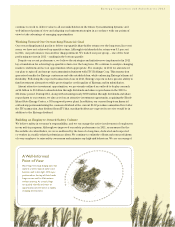Entergy 2011 Annual Report Download - page 7
Download and view the complete annual report
Please find page 7 of the 2011 Entergy annual report below. You can navigate through the pages in the report by either clicking on the pages listed below, or by using the keyword search tool below to find specific information within the annual report.
We can’t change the perception of the political risk associated
with nuclear power overnight; not when countries like Germany
announce their intent to exit nuclear generation completely, or
when a technology-savvy country like Japan experiences an event
like Fukushima. All we can do is continue to safely operate our
plants at the highest possible performance levels, ensure we do
not shortchange risk management in the design, investment and
maintenance of our plants, assure that the public has the facts
relative to the safety of our plants, and rely on the regulatory and
legal systems to protect our right to operate a safe plant.
More generally, the strategies, plans and initiatives under
way today set the foundation toward our vision of the future for
Entergy and the industry.
Our Utility Business:
Finding Opportunity in Challenge
Our utility business is committed to safely providing affordable,
reliable and clean power to its customers. In years past, our
utility operating companies have faced multiple challenges to
achieving that goal. They have worked diligently to develop
solutions to address each challenge.
One of our top priorities has been to secure flexible regulatory
mechanisms that allow our utility operating companies the
opportunity to earn returns commensurate with investment
alternatives of comparable risk. In recent years, we realized
significant improvement in achieving authorized returns on equity.
In fact, over the last 12 months, we were near the top of our
industry in making the most of the opportunities available to us.
All Entergy jurisdictions use alternative rate recovery mechanisms
including riders and/or Formula Rate Plans to reduce regulatory
lag. While efficient and effective, they do not eliminate the need
for rate cases. Late last year, we filed a base rate case in Texas,
and plan to make rate case filings in Louisiana by January 2013.
In other jurisdictions, including Arkansas, the next base rate
case is likely to align with the timing related to the System
Agreement exits and the proposed move to MISO.
Our utility operating companies also moved to address their
ongoing generation capacity needs. Examples of the build, buy
or contract actions taken in 2011 include: Entergy Arkansas
and Entergy Mississippi each announced plans to purchase a
combined-cycle gas-turbine unit; Entergy Louisiana requested
regulatory approval to build a 550-megawatt CCGT unit at its
existing Ninemile Point plant, including selling a portion of
the output to Entergy Gulf States Louisiana and Entergy
New Orleans; and Entergy Texas entered into a 10-year,
485-megawatt power purchase agreement with Calpine Energy
Services, L.P., with 50 percent of the output to be sold to Entergy
Gulf States Louisiana. Thanks in part to these types of efforts to
develop efficient regulatory constructs and identify opportunities
to meet our customers’ long-term generation needs, the past
five-year increase in average residential rates for Entergy utility
customers was substantially less than the U.S. average. At the
same time, customer service performance improved.
Finally, our utility operating companies continued to work
tirelessly in 2011 to find an acceptable solution to address
the upcoming exits of two utility operating companies from
the System Agreement as well as long-term arrangements for
the transmission business. After comprehensive review and
analysis, we determined that joining MISO is expected to provide
substantial long-term benefits for Entergy utility customers.
We identified potential customer savings of up to $1.4 billion
in power production and related costs in the 2013 to 2022
time frame. These benefits derive from joining an RTO with
substantial scale and a “Day Two” market. “Day Two” refers to an
RTO that includes day-ahead and real-time energy markets. MISO
has a functioning “Day Two” market today that will generate
savings for our customers on day one. The other RTO evaluated –
the Southwest Power Pool – does not, even though comparative
cost-benefit analysis assumed SPP will get there by December
2013. Formal requests to join MISO have been filed, or are being
prepared for filing, with our retail regulators. Decisions are
expected by fall 2012.
Joining MISO effectively provides a reliable and cost-effective
option for Entergy Arkansas and Entergy Mississippi to exit
the System Agreement in December 2013 and November 2015,
respectively. It replaces the expiring Independent Coordinator
of Transmission arrangement for the system. The target
implementation date is by December 2013 for transferring
functional control of transmission facilities to MISO.
Given the numerous challenges faced and overcome in
recent years, it’s fair to say our utility business sets a standard
for successful adaptation in a difficult climate of change. It
has a long record of delivering affordable, reliable power to
its customers and is on track to deliver 6 percent to 8 percent
compound average annual net income growth over the 2010 to
2014 period (2009 base year), set before the announcement of
the spin-merge of the transmission business. Details on how
the long-term financial outlook will be affected by the proposed
transmission business spin-off and merger will be provided at
a future date. It is important to note that, with a 2013 targeted
closing date, the transmission business will be part of the utility
for a majority of the duration of this financial outlook, and
Entergy’s shareholders will continue to have ownership in
both businesses after the transaction closes.
Entergy Corporation and Subsidiaries 2011
5

